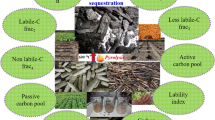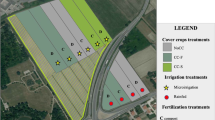Abstract
In French West Indies, the high dependency of the electricity mix on imported fossil fuels has led local authorities to propose the conversion of some land to the production of energy cane. This conversion mainly concerns land polluted by the pesticide chlordecone, where most crops for human consumption have been banned. This molecule has a strong affinity for soil organic matter (SOM). The aims of this study were to assess the impact of crop residue management and compost application on the stocks of SOM and chlordecone in soils cultivated with energy cane and to determine the minimum SOM input required to maintain SOM stocks. A field experiment was conducted to determine the yield and biomass partitioning of energy cane, and laboratory incubations were performed to estimate humification from crop residues. Changes in SOM and chlordecone stocks over a 30-year period were investigated using models already calibrated for the land under study. Non-harvestable biomass left on the field (tops, litterfall and roots) covered >60 % of SOM mineralization. A full offset of mineralization required the return of 10 % of harvestable biomass or the application of compost at a rate of 40 Mg ha−1 every 5 years. With the total removal of harvestable biomass and without compost applications, SOM and chlordecone losses increased by 23 and 13 %, respectively, which was associated with high SOM mineralization and chlordecone leaching under tropical climate. The estimated break-even price for cane biomass indicated that compost application would be more profitable for farmers than the return of a part of the harvestable biomass.



Similar content being viewed by others
References
Organization of American States (2012) Energy policy and sector analysis in the Caribbean 2010–2011. http://www.ecpamericas.org/data/files/Initiatives/lccc_caribbean/LCCC_Report_Final_May2012.pdf. Accessed 23 September 2015
de Cuba K, Rivera-Ramírez M (2007) Background discussion paper on bio-energy potential for St. Kitts and Nevis. Global Sustainable Energy Islands Initiative. http://www.oas.org/dsd/reia/documents/gseii/stkittsnevis/background_discussion_paper_final_oas_gseii.pdf. Accessed 23 September 2015
Conseil Regional de la Guadeloupe (2010) Valorisation énergétique de la biomasse en Guadeloupe: état des lieux et perspectives. http://www.guadeloupe-energie.gp/wp-content/uploads/2010-10-01_Biomasse_Etat-des-lieux.pdf. Accessed 10 September 2015
Matsuoka S, Kennedy AJ, dos Santos EGD, Tomazela AL, Rubio LCS (2014) Energy cane: its concept, development, characteristics, and prospects. Advances in Botany. doi:10.1155/2014/597275
Sabatier D, Martin JF, Chiroleu F, Roussel C, Letourmy P, Van Antwerpen R, Gabrielle B, Ney B (2015) Optimization of sugarcane farming as a multipurpose crop for energy and food production. Glob Change Biol Bioenergy 7:40–56
Cabidoche YM, Achard R, Cattan P, Clermont-Dauphin C, Massat F, Sansoulet J (2009) Long-term pollution by chlordecone of tropical volcanic soils in the french West Indies: a simple leaching model accounts for current residue. Environ Pollut 157:1697–1705
Saunders L, Kadhel P, Costet N, Rouget F, Monfort C, Thomé JP, Guldner L, Cordier S, Multigner L (2014) Hypertensive disorders of pregnancy and gestational diabetes mellitus among French Caribbean women chronically exposed to chlordecone. Environ Int 68:171–176
Cabidoche YM, Lesueur-Jannoyer M (2012) Contamination of harvested organs in root crops grown on chlordecone-polluted soils. Pedosphere 22:562–571
Gillingham KT, Smith SJ, Sands RD (2007) Impact of bioenergy crops in a carbon dioxide constrained world: an application of the MiniCAM energy-agriculture and land use model. Mitig Adapt Strateg Glob Chang. doi:10.1007/s11027-007-9122-5
Immerzeel D, Verweij PA, Van der Hilst F, Faaij APC (2014) Biodiversity impacts of bioenergy crop production: a state-of-the-art review. Glob Change Biol Bioenergy 6:183–209
Saffih-Hdadi K, Mary B (2008) Modeling consequences of straw residues export on soil organic carbon. Soil Biol Biochem 40:594–607
Blanco-Canqui H (2013) Crop residue removal for bioenergy reduces soil carbon pools: how can we offset carbon losses? Bioenerg Res 6:358–371
Smith P, Davies CA, Ogle S, Zanchi G, Bellarby J, Bird N, Boddey RM, McNamara NP, Powlson D, Cowie A, Van Noordwijk M, Davis SC, Richter DB, Kryzanowski L, Van Wijk MT, Stuart J, Kirton A, Eggar D, Newton-Cross G, Adhya TK, Braimoh A (2012) Towards an integrated global framework to assess the impacts of land use and management change on soil carbon: current capability and future vision. Glob Chang Biol 18:2089–2101
Turmel MS, Speratti A, Baudron F, Verhulst N, Govaerts B (2015) Crop residue management and soil health: a systems analysis. Agric Syst 134:6–16
Don A, Osborne B, Hastings A, Skiba U, Carter MS, Drewer J, Flessa H, Freibauer A, Hyvönen N, Jones MB, Lanigan G, Mander Ü, Monti A, Djomo SN, Valentine J, Zegada-Lizarazu W, Zenone T (2012) Land-use change to bioenergy production in Europe: implications for the greenhouse gas balance and soil carbon. Glob Change Biol Bioenergy 4:372–391
Sierra J, Causeret F, Diman JL, Publicol M, Desfontaines L, Cavalier A, Chopin P (2015) Observed and predicted changes in soil carbon stocks under export and diversified agriculture in the Caribbean. The case study of Guadeloupe. Agric Ecosyst Environ 213:252–264
Monforti F, Lugato E, Motola V, Bodis K, Scarlat N, Dallemand JF (2015) Optimal energy use of agricultural crop residues preserving soil organic carbon stocks in Europe. Renew Sust Energ Rev 44:519–529
Kludze H, Deen B, Weersink A, van Acker R, Janovicek K, De Laporte A, McDonald I (2013) Estimating sustainable crop residue removal rates and costs based on soil organic matter dynamics and rotational complexity. Biomass Bioenergy 56:607–618
Anderson-Teixeira KJ, Davis SC, Masters MD, DeLucia EH (2009) Changes in soil organic carbon under biofuel crops. Glob Change Biol Bioenergy 1:75–96
Mello FFC, Cerri CEP, Davies CA, Holbrook NM, Paustian K, Maia SMF, Galdos MV, Bernoux M, Cerri CC (2014) Payback time for soil carbon and sugar-cane ethanol. Nat Clim Chang 4:605–609
Chopart JL, Bachelier B (2012) Propriétés et performances comparées de 16 cultivars de Poacées (Saccharum sp. et Erianthus) en vue d’un usage énergétique. Proc. Congrès AFCAS ARTAS, La Réunion, France. https://agritrop.cirad.fr/566633. Accessed 21 September 2015
Chopart JL, Bonnal L, Martiné JF, Sabatier D (2013) Functional relationships between dry above-ground biomass and the energy yield of sugarcane. Proc. of the XXVIII International Society of Sugar Cane Technologists Congress, São Paulo, Brazil, https://agritrop.cirad.fr/570786. Accessed 21 September 2015
Yannick B, Dagallier JC, Ganot P, Mathieu C, Mounigan B, Urbino A, Wagner N (2005) Manuel technique de la canne à sucre. CTICS, Abymes, Guadeloupe
Böhm W (1979) Monolith methods. Ecol Stu An 33:20–38
Azevedo M, Chopart JL, Medina de Conti C (2011) Sugarcane root length density and distribution from root intersection counting on a trench-profile. Sci Agric 68:94–101
Sierra J, Motisi N (2012) Shift in C and N humification during legume litter decomposition in an acid tropical Ferralsol. Soil Res 50:380–389
Nicolardot B, Recous S, Mary B (2001) Simulation of C and N mineralisation during crop residue decomposition: a simple dynamic model based on the C:N ratio of the residues. Plant Soil 238:83–103
Raphael L, Sierra J, Recous S, Ozier-Lafontaine H, Desfontaines L (2012) Soil turnover of crop residues from the banana (Musa AAA cv. Petite-Naine) mother plant and simultaneous uptake by the daughter plant of released nitrogen. Eur J Agron 38:117–123
Vermerris W (2011) Survey of genomics approaches to improve bioenergy traits in maize, sorghum and sugarcane. J Integr Plant Biol 53:105–119
Kätterer T, Bolinder MA, Andrén O, Kirchmann H, Menichetti L (2011) Roots contribute more to refractory soil organic matter than above-ground crop residues, as revealed by a long-term field experiment. Agric Ecosyst Environ 141:184–192
Corbeels M, McMurtrie RE, Pepper DA, O’Connell AM (2005) A process-based model of nitrogen cycling in forest plantations. Part I. Structure, calibration and analysis of the decomposition model. Ecol Model 187:426–448
Justes E, Mary B, Nicolardot B (2009) Quantifying and modelling C and N mineralization kinetics of catch crop residues in soil: parameterization of the residue decomposition module of STICS model for mature and non mature residues. Plant Soil 325:171–185
Pikul JL, Johnson JMF, Schumacher TE, Vigil M, Riedell WE (2008) Change in surface soil carbon under rotated corn in eastern South Dakota. Soil Sci Soc Am J 72:1738–1744
Tarkalson DD, Bjorneberg DL, Brown B, Kok H, Bjorneberg DL (2011) Small grain residue management effects on soil organic carbon: a literature review. Agron J 103:247–252
Fernández-Bayo JD, Saison C, Voltz M, Disko U, Hofmann D, Berns AE (2013) Chlordecone fate and mineralisation in a tropical soil (andosol) microcosm under aerobic conditions. Sci Total Environ 463–464:395–403
Merlin C, Devers M, Crouzet O, Heraud C, Steinberg C, Mougin C, Martin-Laurent F (2014) Characterization of chlordecone-tolerant fungal populations isolated from long-term polluted tropical volcanic soil in the French West Indies. Environ Sci Pollut Res 21:4914–4927
Ministère de la Santé et des Affaires Sociales (2011) Plan d’action contre la pollution par la chlordécone en Guadeloupe et en Martinique 2011–2013. http://www.sante.gouv.fr/plan-d-action-chlordecone-en-martinique-et-en-guadeloupe-2008-2010.html. Accessed 9 September 2015
Clostre F, Woignier T, Rangon L, Fernandes P, Soler A, Lesueur-Jannoyer M (2014) Field validation of chlordecone soil sequestration by organic matter addition. J Soils Sediments 14:23–33
Parkinson R, Gibbs P, Burchett S, Misselbrook T (2004) Effect of turning regime and seasonal weather conditions on nitrogen and phosphorus losses during aerobic composting of cattle manure. Bioresour Technol 91:171–178
Sierra J, Desfontaines L, Faverial J, Loranger-Merciris G, Boval M (2013) Composting and vermicomposting of cattle manure and greenwastes under tropical conditions: carbon and nutrient balances and end-product quality. Soil Res 51:142–151
Acknowledgments
This study formed part of the Recherche Biomasse-Energie Canne à Capesterre Belle-Eau Project (Rebecca Grant No. 1/1.4/33634) funded by the European Regional Development Fund (FEDER). We thank the three anonymous reviewers for their constructive comments, which helped us to improve the manuscript.
Author information
Authors and Affiliations
Corresponding author
Rights and permissions
About this article
Cite this article
Sierra, J., Chopart, J.L., Guindé, L. et al. Optimization of Biomass and Compost Management to Sustain Soil Organic Matter in Energy Cane Cropping Systems in a Tropical Polluted Soil: a Modelling Study. Bioenerg. Res. 9, 798–808 (2016). https://doi.org/10.1007/s12155-016-9729-z
Published:
Issue Date:
DOI: https://doi.org/10.1007/s12155-016-9729-z




